Robotic Vacuum Cleaner Market Size
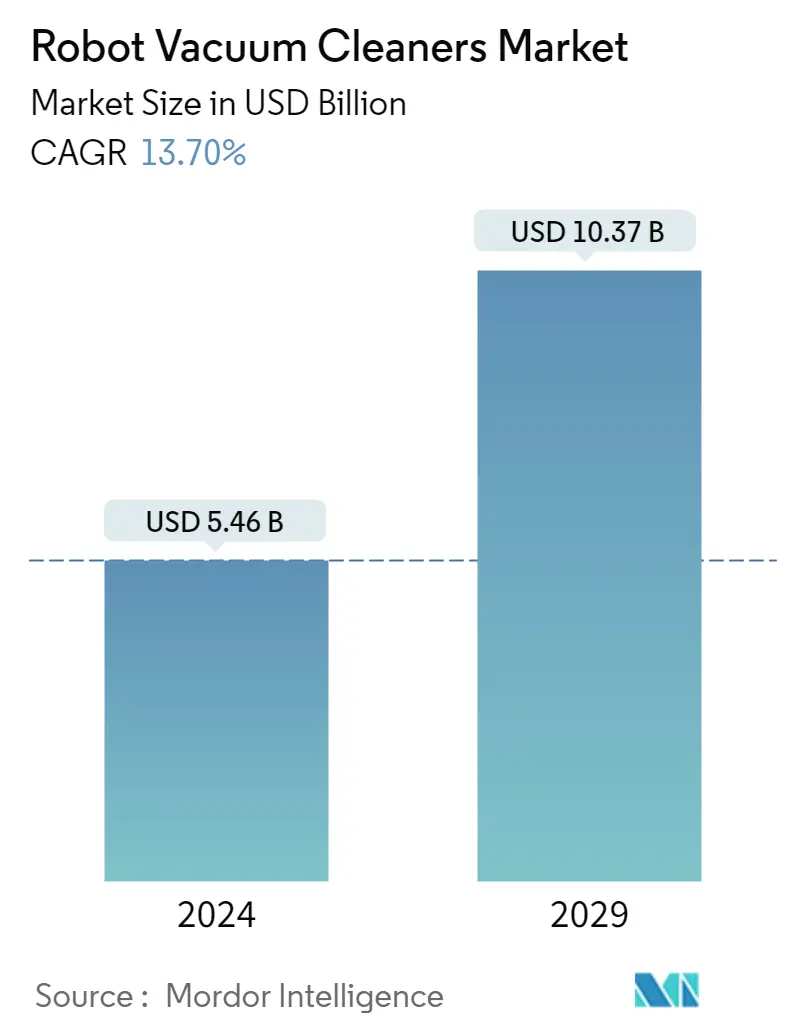
| Study Period | 2019 - 2029 |
| Market Size (2024) | USD 5.46 Billion |
| Market Size (2029) | USD 10.37 Billion |
| CAGR (2024 - 2029) | 13.70 % |
| Fastest Growing Market | Asia Pacific |
| Largest Market | Europe |
Major Players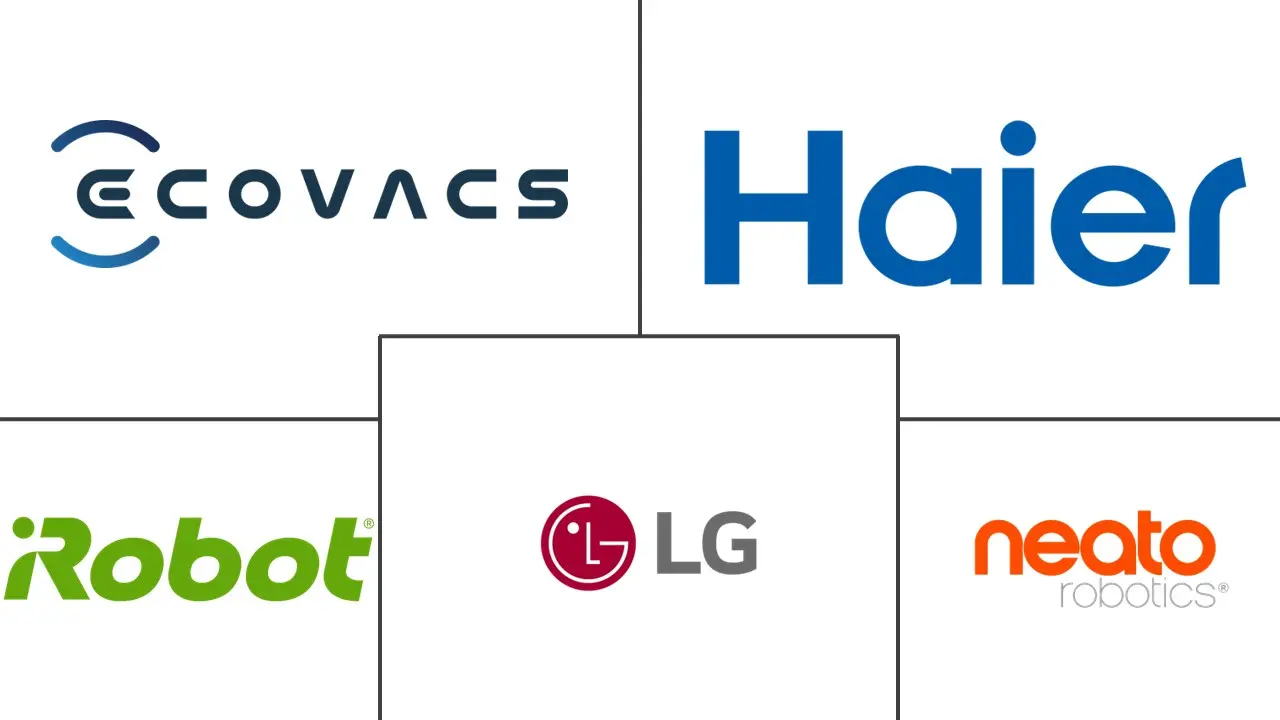
*Disclaimer: Major Players sorted in no particular order |
Robotic Vacuum Cleaner Market Analysis
The Robot Vacuum Cleaners Market size is estimated at USD 5.46 billion in 2024, and is expected to reach USD 10.37 billion by 2029, growing at a CAGR of 13.70% during the forecast period (2024-2029).
The growth in demand for diverse robotic applications across various industries and robotic industry improvements are two key factors motivating companies to invest in the market.
- One of the main factors influencing the growth of the robot vacuum cleaner market is the rising demand for domestic consumer robots and the increasing investment in R&D of personal service robots for aid in various household applications.
- The key driver of domestic robot adoption also includes increased customer awareness. Market players, including Future Robot, Ecovacs, Hanool Robotics, and iRobot Corporation, are investing more in R&D to provide cutting-edge domestic service robots for assistance in various household applications.
- The growing reach of Internet facilities and the widespread availability of the 5G network are factors boosting the market growth. Additionally, the global market for robotic vacuum cleaners has expanded as the culture of household chores has changed. The self-driving vacuum cleaner has also become increasingly popular.
- Consumers are more likely to purchase robotic vacuum cleaners today because of their ability to clean the area without human intervention. As these robots can automatically navigate themselves toward the charging station and restart from the same position at which it was drained, consumers don't need to bother about battery recharging. Customers can restrict admission to certain areas, such as a child's playroom, and define virtual boundaries for the robot.
- However, factors such as the expensive installation costs combined with the high cost of robot vacuum cleaner maintenance are impeding market expansion.
- In addition, people were forced to spend several weeks during the COVID-19 outbreak confined to their homes with little contact with the outside world-this increased demand for home automation in numerous nations. Consumer demand from tier-3 and beyond markets has significantly increased, making up about half of the total demand for home automation devices, while demand from metro areas has remained stable. This has also increased the demand for robot vacuum cleaners.
Robotic Vacuum Cleaner Market Trends
This section covers the major market trends shaping the Robot Vacuum Cleaners Market according to our research experts:
Residential Households to Witness Fastest Growth
- The increase in disposable income, dual-income households, and lifestyle changes are key drivers in this market, enabling consumers in emerging nations to purchase AI-based smart devices such as robotic cleaning products. Due to its growth in Europe, North America, and Asia-Pacific, the need for smart homes is increasing on a global scale.
- In developed countries, market vendors are also increasingly targeting commercial cleaning applications. They offer a product that enables carpets to collect dirt, dust, dander, and bacteria, especially in public places, like an airport or hotel lobby.
- Over the forecasted period, demand for robotic vacuum cleaners is anticipated to increase due to the development of robotic vacuum cleaners and the adoption of cutting-edge technology like Wi-Fi connectivity, artificial intelligence (AI) capabilities, and voice assistance (VA) in smart homes and commercial activities. To keep up with the continuously shifting demands of their customers, many companies concentrate on developing and providing cutting-edge new products.
- Due to the time and effort they save, consumers across all market sectors are placing a premium on automated products. As consumers use automated cleaners more frequently, which encourages the use of smart home technology, market growth is projected. However, conventional construction methods and intelligent homes are now within reach and gaining popularity due to advancements in electronics and their smooth integration with earlier technologies.
- The latest robotic vacuum models can also converse with Google Assistant or Amazon's Alexa to comprehend and execute audible commands. The interoperability of smart home and Internet of Things (IoT) devices may create new markets and commercial opportunities for manufacturers of robotic vacuum cleaners.
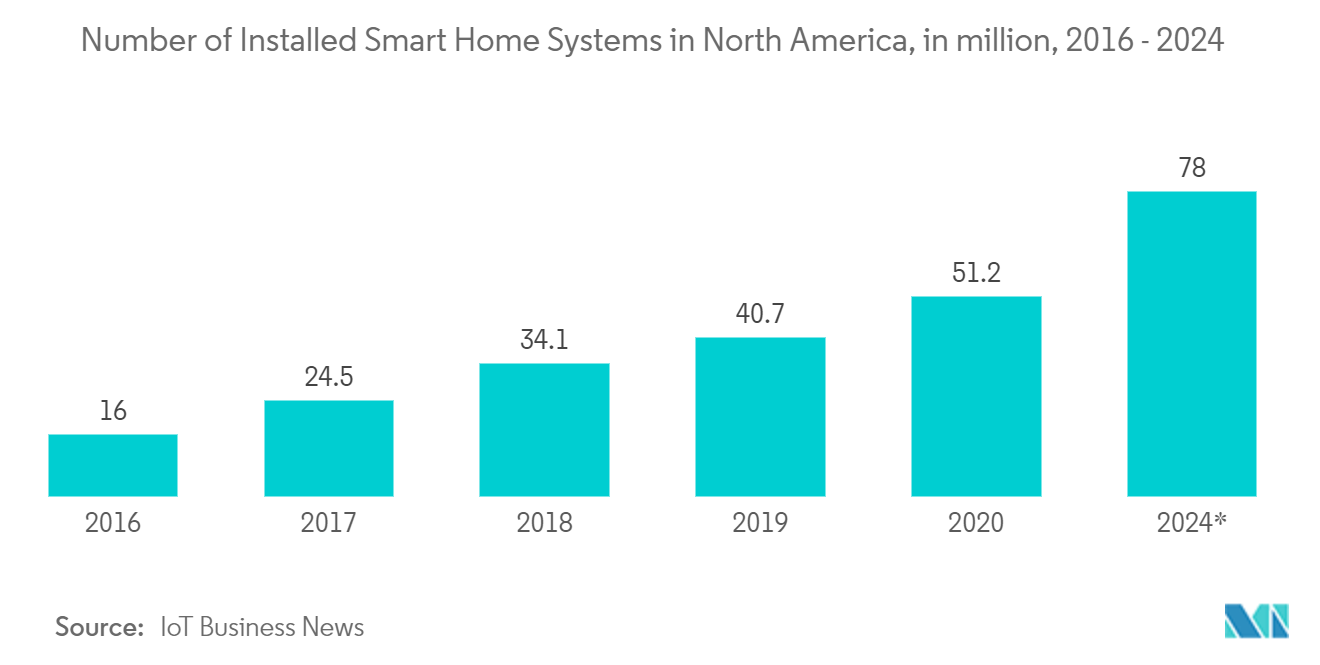
North America to Occupy the Largest Market Share
- North America, among the leading innovators and pioneers in the adoption of robotics, is one of the largest markets. The primary reason for the market's growth is the increasing adoption of domestic robots across the region.
- One of the key nations that have contributed considerably to expand the worldwide market for robot vacuum cleaners in recent years is the United States. The nation is a significant investor and inventor in the area under study. The United States is home to several of the largest and most well-known businesses in the sector under investigation. Vendors in the US market are known for their cutting-edge products. However, most of these businesses outsourced their manufacturing tasks and concentrated their engineering efforts on robot design.
- The United States, followed by Canada, records the highest growth rate, owing to the significant adoption of robot vacuum cleaners throughout the region. The primary factor boosting the market growth in the region is the gradual rise in the disposable income of the consumers in the region and the rapid change in people's lifestyles.
- With the effective implementation of 5G in the United States and better Wi-Fi technology, such as Wi-Fi 6, the market for robotic vacuum cleaners is significantly rising and is likely to continue growing in the forecast period due to the increasing acceptance of smart home technology and products in the North America region followed by the United States.
- Moreover, among all the household robots, automated vacuum cleaners and moppers are the most commercialized and developed products. Regional companies are continuously investing in developing more compact and integrated vacuum cleaners and mopping robots to reach small places at home.
- The vendors in the region under study rely heavily on several single-source contract manufacturers, primarily based in Asia-Pacific. However, most of these businesses are moving their manufacturing facilities, which has become an expensive and time-consuming due to the current US-China trade war and other geopolitical difficulties.
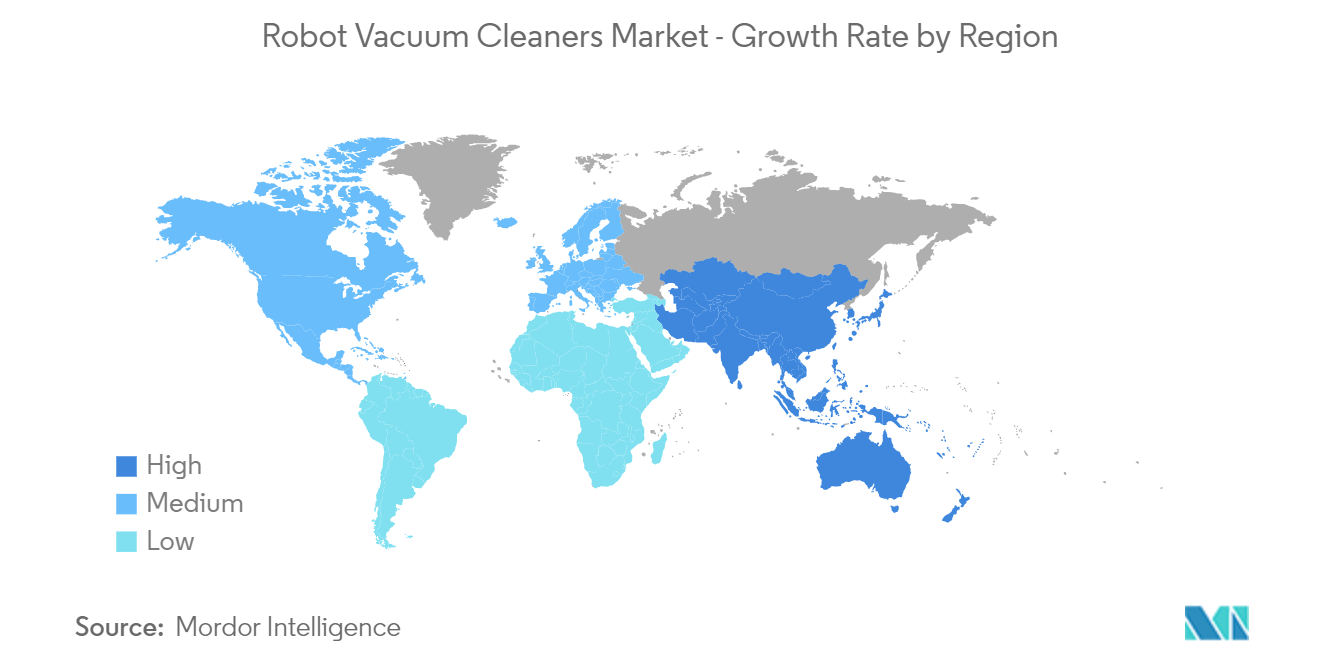
Robotic Vacuum Cleaner Industry Overview
The robot vacuum cleaners market is very competitive primarily due to the presence of major players such as iRobot Corporation and Neato Robotics (Vorwerk). Furthermore, the probability of new players entering the market is moderately high, which could further intensify the market competition. Product launch, high expense on research and development, and strategic partnerships and acquisitions are the prime growth strategy followed by the companies to sustain the intense competition.
In October 2022, Ecovacs launched DEEBOT N8 2-in-1 with upgraded suction power and advanced dToF technology, ensuring better cleaning efficiency and the most powerful suction (3000 Pa). It covers 2000+ Sq. Ft in one charge and has advanced dToF Technology with OZMO Mopping. It is the Next-Gen laser guidance technology that precisely scans, maps, and plans an efficient cleaning path.
In June 2022, Global consumer robot company iRobot Corp unveiled a premium Roomba J7+ smart vacuum cleaner with iRobot OS in India. The new smart-vacuum cleaner currently sits with the existing Roomba i7 series, S9 series, i3 series, and more. Similar to its existing product series, the Roomba i7 series includes two models - the regular Roomba J7 and Roomba J7+, though the latter is only available in the country.
Robotic Vacuum Cleaner Market Leaders
-
iRobot Corporation
-
Neato Robotics ( Vorwerk)
-
Ecovacs Robotics
-
LG Electronics Inc.
-
Haeir Group Corporation
*Disclaimer: Major Players sorted in no particular order
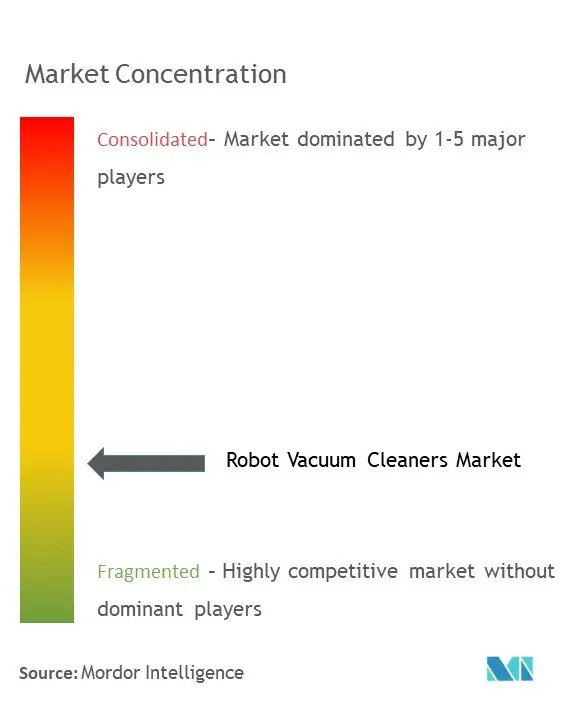
Robotic Vacuum Cleaner Market News
- August 2022: Amazon announced signing a deal with iRobot, maker of Roomba robot vacuum cleaners, to acquire the company for USD 1.7 billion. iRobot, known for its robotic vacuum Roomba, has since expanded its product lineup to include other home cleaning robots such as mops and lawnmowers.
- May 2022: Haier unveiled its first-ever smart Vacuum Cleaner technology - the 2-in1 dry & wet mop Robot Vacuum Cleaner in India. The vacuum cleaner is equipped with 2.4 GHz Wi-Fi and Google Home Assistant and offers smart management with the Haier smart app, voice control, and also remote control.
Robotic Vacuum Cleaner Market Report - Table of Contents
1. INTRODUCTION
- 1.1 Study Assumptions and Market Definition
- 1.2 Scope of the Study
2. RESEARCH METHODOLOGY
3. EXECUTIVE SUMMARY
4. MARKET INSIGHTS
- 4.1 Market Overview
- 4.2 Industry Value Chain Analysis
-
4.3 Industry Attractiveness - Porter's Five Forces Analysis
- 4.3.1 Bargaining Power of Suppliers
- 4.3.2 Bargaining Power of Consumers
- 4.3.3 Threat of New Entrants
- 4.3.4 Intensity of Competitive Rivalry
- 4.3.5 Threat of Substitutes
- 4.4 Assessment of the COVID-19 Impact on the Industry
5. MARKET DYNAMICS
-
5.1 Market Drivers
- 5.1.1 Changing Consumer Preferences and Socio-economic Factors Along with Reduced Unit Prices
-
5.2 Market Challenges
- 5.2.1 Distribution Channel Analysis Online vs Offline
6. MARKET SEGMENTATION
-
6.1 By Type
- 6.1.1 Floor Cleaner
- 6.1.2 Pool Cleaner
- 6.1.3 Window Cleaner
-
6.2 By End-user
- 6.2.1 Commercial
- 6.2.2 Residential
-
6.3 By Geography
- 6.3.1 North America
- 6.3.1.1 United States
- 6.3.1.2 Canada
- 6.3.2 Europe
- 6.3.2.1 Germany
- 6.3.2.2 United Kingdom
- 6.3.2.3 France
- 6.3.2.4 Rest of Europe
- 6.3.3 Asia-Pacific
- 6.3.3.1 China
- 6.3.3.2 Japan
- 6.3.3.3 South Korea
- 6.3.3.4 Rest of Asia Pacific
- 6.3.4 Rest of the World
7. COMPETITIVE LANDSCAPE
- 7.1 Pricing Analysis
-
7.2 Company Profiles
- 7.2.1 Ecovacs Robotics Co. Ltd
- 7.2.2 Roborock Technology Co. Ltd
- 7.2.3 LG Electronics Inc.
- 7.2.4 iRobot Corporation
- 7.2.5 Cecotec Innovaciones SL
- 7.2.6 Neato Robotics Inc.
- 7.2.7 Electrolux AB
- 7.2.8 SharkNinja Operating LLC
- 7.2.9 Panasonic Corporation
- 7.2.10 Haier Group Corporation
- 7.2.11 Hitachi Ltd
- 7.2.12 Samsung Electronics Co. Ltd
- *List Not Exhaustive
8. INVESTMENT ANALYSIS
9. MARKET OPPORTUNITIES AND FUTURE TRENDS
** Subject To AvailablityRobotic Vacuum Cleaner Industry Segmentation
Robotic vacuum cleaners are designed to clean autonomously without human control. North America occupies the largest market share, while Asia-Pacific is expected to be the fastest-growing market. Robots used for professional cleaning-related activities - including floor cleaning, window and wall cleaning, sewers, tank, tube, and pipe cleaning, and hull cleaning (aircraft, vehicles, ships, etc.), among others, are considered in the segment scope.
The Robot Vacuum Cleaners Market is segmented by By Type (Floor Cleaner, Pool Cleaner, Window Cleaner), End-user (Commercial, Residential), and Geography (North America (United States, and Canada), Europe (Germany, United Kingdom, France, and Rest of Europe), Asia-Pacific (China, Japan, South Korea, and Rest of Asia Pacific), and Rest of the World). The market sizes and forecasts are provided in terms of value (USD million) for all the above segments.
| By Type | Floor Cleaner | |
| Pool Cleaner | ||
| Window Cleaner | ||
| By End-user | Commercial | |
| Residential | ||
| By Geography | North America | United States |
| Canada | ||
| By Geography | Europe | Germany |
| United Kingdom | ||
| France | ||
| Rest of Europe | ||
| By Geography | Asia-Pacific | China |
| Japan | ||
| South Korea | ||
| Rest of Asia Pacific | ||
| By Geography | Rest of the World |
Robotic Vacuum Cleaner Market Research FAQs
How big is the Robot Vacuum Cleaners Market?
The Robot Vacuum Cleaners Market size is expected to reach USD 5.46 billion in 2024 and grow at a CAGR of 13.70% to reach USD 10.37 billion by 2029.
What is the current Robot Vacuum Cleaners Market size?
In 2024, the Robot Vacuum Cleaners Market size is expected to reach USD 5.46 billion.
Who are the key players in Robot Vacuum Cleaners Market?
iRobot Corporation, Neato Robotics ( Vorwerk), Ecovacs Robotics, LG Electronics Inc. and Haeir Group Corporation are the major companies operating in the Robot Vacuum Cleaners Market.
Which is the fastest growing region in Robot Vacuum Cleaners Market?
Asia Pacific is estimated to grow at the highest CAGR over the forecast period (2024-2029).
Which region has the biggest share in Robot Vacuum Cleaners Market?
In 2024, the Europe accounts for the largest market share in Robot Vacuum Cleaners Market.
What years does this Robot Vacuum Cleaners Market cover, and what was the market size in 2023?
In 2023, the Robot Vacuum Cleaners Market size was estimated at USD 4.80 billion. The report covers the Robot Vacuum Cleaners Market historical market size for years: 2019, 2020, 2021, 2022 and 2023. The report also forecasts the Robot Vacuum Cleaners Market size for years: 2024, 2025, 2026, 2027, 2028 and 2029.
What is the future outlook for the Robot Vacuum Cleaner Market?
The Robot Vacuum Cleaner Market is expected to grow significantly in the future due to continuous technological advancements, increasing consumer demand for convenience, and growing smart home integration.
What challenges does the Robot Vacuum Cleaner Market face?
The major challenges faced by the Robot Vacuum Cleaner Market include: a) High product costs b) Maintenance issues c) Competition from traditional vacuum cleaners
Robotic Vacuum Cleaner Industry Report
The global robotic vacuum cleaner market is experiencing significant growth, driven by a rising interest in smart home technology and automated products for both residential and commercial sectors. Key insights highlight the market's promising future, driven by technological advancements and evolving consumer needs. The market analysis reveals that innovations such as Wi-Fi, AI, and voice assistance are enhancing the appeal of these products. Despite the hurdles of high costs, the market thrives, supported by diverse distribution channels and a strong push in the Asia Pacific region.
The industry analysis covers market share, market size, revenue growth, and forecasts, offering a comprehensive overview of the industry's potential. The market forecast indicates a notable demand in commercial and industrial segments for their efficiency in cleaning larger areas and specialized environments like offices, hotels, manufacturing, and healthcare facilities. The market growth is further supported by technological advancements and evolving consumer needs.
The market outlook and market overview provide a detailed examination of current trends and future predictions. This report example includes market segmentation by type, end-user, and geography, showcasing the rise of industrial and commercial robot vacuum cleaners. The market leaders are identified through thorough industry research and market data.
The industry outlook and industry trends indicate a strong future for robotic vacuum cleaners, driven by continuous innovation and consumer demand. The industry reports and industry information provide valuable insights into market value and market review. The market predictions and market segmentation highlight the diverse applications and potential growth areas within the market.
The report pdf offers an in-depth analysis of the market, helping research companies and stakeholders understand the market dynamics. The industry statistics and industry size emphasize the growing importance of robotic vacuum cleaners in both residential and commercial settings. The industry sales and market value further underscore the market's expansion and potential.
In conclusion, the residential robotic vacuum cleaner manufacturers market is set for substantial growth, with a comprehensive analysis of market trends, market data, and industry outlook. The report provides a detailed market review, helping stakeholders make informed decisions based on accurate market predictions and industry research.



